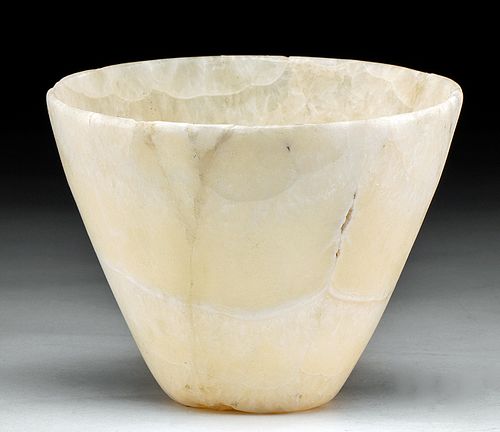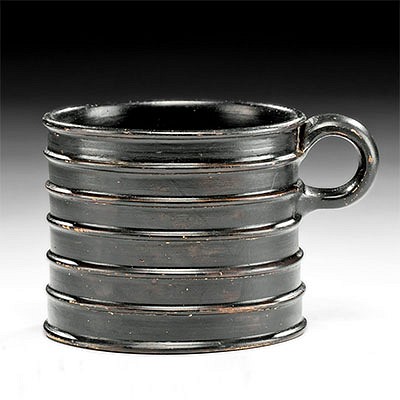Fine Egyptian Banded Alabaster Bowl
Lot 8a
About Seller
Artemis Fine Arts
686 S Taylor Ave, Ste 106
Louisville, CO 80027
United States
Selling antiquities, ancient and ethnographic art online since 1993, Artemis Gallery specializes in Classical Antiquities (Egyptian, Greek, Roman, Near Eastern), Asian, Pre-Columbian, African / Tribal / Oceanographic art. Our extensive inventory includes pottery, stone, metal, wood, glass and textil...Read more
Categories
Estimate:
$1,800 - $2,500
Absentee vs Live bid
Two ways to bid:
- Leave a max absentee bid and the platform will bid on your behalf up to your maximum bid during the live auction.
- Bid live during the auction and your bids will be submitted real-time to the auctioneer.
Bid Increments
| Price | Bid Increment |
|---|---|
| $0 | $25 |
| $300 | $50 |
| $1,000 | $100 |
| $2,000 | $250 |
| $5,000 | $500 |
| $10,000 | $1,000 |
| $20,000 | $2,500 |
| $50,000 | $5,000 |
| $100,000 | $10,000 |
| $200,000 | $20,000 |
About Auction
By Artemis Fine Arts
Mar 12, 2020
Set Reminder
2020-03-12 10:00:00
2020-03-12 10:00:00
America/New_York
Bidsquare
Bidsquare : Ancient / Ethnographic Around The World
https://www.bidsquare.com/auctions/artemis-gallery/ancient-ethnographic-around-the-world-4957
Ancient art from Egypt, Greece, Italy and the Near East, as well as Asian, Fossils, Pre-Columbian, Native American, African / Tribal / Oceanic, Spanish Colonial, Russian Icons, Fine art, much more! Artemis Fine Arts info@artemisfinearts.com
Ancient art from Egypt, Greece, Italy and the Near East, as well as Asian, Fossils, Pre-Columbian, Native American, African / Tribal / Oceanic, Spanish Colonial, Russian Icons, Fine art, much more! Artemis Fine Arts info@artemisfinearts.com
- Lot Description
Egypt, Late Dynastic Period, 26th to 31st Dynasty, ca. 664 to 332 BCE. A gorgeous bowl of a broad, conical form that is hand-carved from translucent yellow-white alabaster with opaque white bands that illuminate when placed next to a light source. The bowl is defined by a slightly rounded but stable base, thick walls that taper to form the rounded rim, and a deep basin. Both the interior and exterior surfaces boast incredibly smooth surface textures. Size: 5.7" W x 4.4" H (14.5 cm x 11.2 cm)
Alabaster was quarried along the length of the Nile, from Giza to just south of Luxor. Offering bowls like these were used in temples and placed in the tombs of people at all class levels. For example, Auguste Mariette, the famous French Egyptologist of the 19th century, found a cemetery for the poor in Memphis where the dead had been buried without wrappings only three feet below the ground; however, each had a small alabaster bowl and some animal bones, as they had been given food and drink for the afterlife. Meanwhile, kings were buried with many vessels, often of the highest quality. These vessels were necessary to provide for the dead during their time in the underworld.
Provenance: ex-private Khan family collection, New Jersey, USA, acquired in the 1980s
All items legal to buy/sell under U.S. Statute covering cultural patrimony Code 2600, CHAPTER 14, and are guaranteed to be as described or your money back.
A Certificate of Authenticity will accompany all winning bids.
We ship worldwide and handle all shipping in-house for your convenience.
#153485Repaired from multiple large pieces, with restoration in a few areas of loss, and resurfacing with light adhesive residue along new material and break lines. Minor abrasions and nicks to base, walls, and rim. Incredibly smooth surface texture throughout.Condition
- Shipping Info
-
All shipping is handled in-house for your convenience. Your invoice from Artemis Gallery will include shipping calculation instructions. If in doubt, please inquire BEFORE bidding for estimated shipping costs for individual items.
-
- Buyer's Premium



 EUR
EUR CAD
CAD AUD
AUD GBP
GBP MXN
MXN HKD
HKD CNY
CNY MYR
MYR SEK
SEK SGD
SGD CHF
CHF THB
THB















